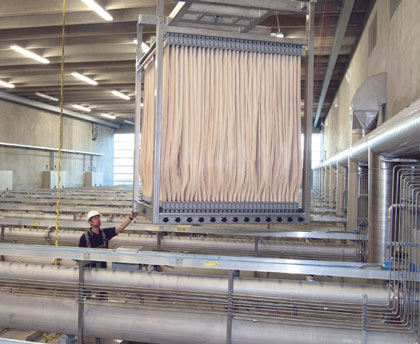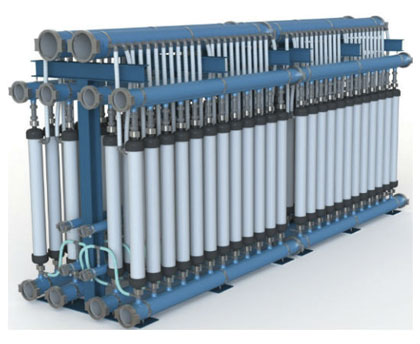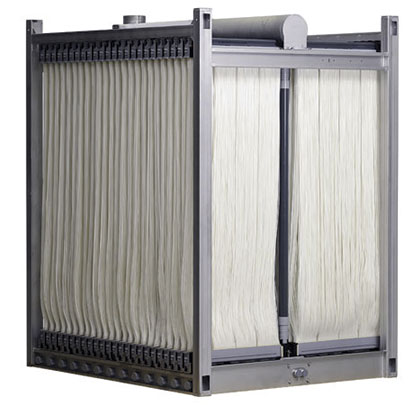As industrial customers seek greater water reuse and repurpose, while facing more stringent discharge limits, creating new designs and applications becomes critical to meet their growing needs. In the future, industrial customers will seek solutions that reuse their wastewater and generate energy to reduce their costs and become energy efficient.
THE ROAD TO RENEWABLE ENERGY
To answer that demand, GE Power & Water’s latest membrane-based wastewater treatment technology combines anaerobic digestion technology with its ZeeWeed 500 membranes to create anaerobic membrane bioreactor (AnMBR). AnMBR offers lower costs, better performance and the ability to generate renewable energy from industrial wastewater.
GE’s new technology is an ideal solution for industrial wastewater with high biochemical oxygen demand and chemical oxygen demand concentrations that result in higher aerobic treatment operational expenses. GE’s AnMBR provides reduced energy consumption, energy recovery and reduced sludge production both economically and reliably.


Featured Image: ZeeWeed 500 hollow fiber membranes.
Above: By combining anaerobic digestion and ZeeWeed membrane technology, GE has solved the issues associated with traditional anaerobic processes.
ZEEWEED IN ANAEROBIC DIGESTION
Anaerobic digestion is a biological process in which microorganisms break down biodegradable material in the absence of oxygen. One of the end products is biogas, which can be combusted to generate electricity and heat. Advantages of anaerobic treatment include energy savings by not requiring oxygen, reduced sludge production and reduced footprint. However, the traditional anaerobic processes have disadvantages such as lesser effluent quality, process sensitivity, slow biomass growth rate, difficulty retaining methanogens and long-time or difficult-to-settle sludge.
GE’s AnMBR separates solids retention time from hydraulic retention time for a more robust biological process, retaining methanogens in anaerobic reactor, increasing methane production with no suspended solids in permeate and improving final effluent quality.
“GE’s most recent development in membranes unites our proven ZeeWeed reinforced hollow fiber membranes with anaerobic digestion technology to construct the new AnMBR. The future of water treatment has a new component and reinforces GE’s commitment to energy neutrality. Our industrial customers are yearning for more energy reduction in wastewater treatment, and GE’s AnMBR will give them a way to generate renewable energy from their wastewater,” says Yuvbir Singh, general manager, engineered systems—water and process technologies for GE Power & Water.

GE’s pressurized ZeeWeed 1500 ultrafiltration membranes are ideal for drinking water treatment, tertiary filtration and pretreatment applications for brackish and seawater desalination for small-to-medium plants requiring quick delivery and installation.
SIMULATION SOFTWARE TO INCLUDE ZEEWEED 1500 MEMBRANES
Over the past three decades GE has continued to expand, refine, and update its Winflows software as technology and design standards have evolved to ensure it is relevant for the water industry. GE has expanded its original RO projection software to include NF projections, chemical addition, pre-treatment, chemical/anti-scalent dosing, the RO/NF system, energy recovery devices and post treatment—all within a single platform.
The latest upgrade to the Winflows reverse osmosis (RO) and nanofiltration (NF) design and simulation software is the inclusion of ZeeWeed 1500 membranes. This new projection software application enables users to design a spiral-wound membrane system with hollow fiber ultrafiltration pre-treatment in a single platform. There are two more significant additions to Winflows. The first is the addition of its newest membrane elements that have been recently launched including the extreme low-energy RO membranes called the AP series and the seawater sulfate reducing NF membranes. The second major upgrade is the ability to choose Mandarin as a language preference.
The extreme low pressure membranes are ideal for high flow and low energy applications. The seawater sulfate removal membranes are specifically targeted for removing sulfate from injection water in offshore oil production. ◆
For more information on AnMBR, contact GE Power & Water’s Jeff Cumin at 905.465.3030 x3105 or jeff.cumin@ge.com. For more information on Winflows, contact GE Power & Water’s Erik Hanson at 952.988.6420 or erik.hanson@ge.com. To download the newest version of Winflows, visit www.gewater.com/winflows.html.
____________________________________________
MODERN PUMPING TODAY, September 2015
Did you enjoy this article?
Subscribe to the FREE Digital Edition of Modern Pumping Today Magazine!
![]()


